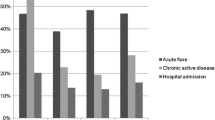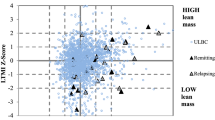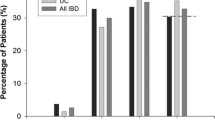Abstract
Background
Obesity is associated with a proinflammatory state.
Aim
To determine whether obesity at diagnosis is a risk factor for Crohn’s disease vs. ulcerative colitis and also vs. community controls and whether there is a U-shaped relationship between body mass index at diagnosis and risk of Crohn’s disease versus ulcerative colitis.
Methods
A total of 524 consecutive inflammatory bowel disease patients attending gastroenterology clinics were administered a questionnaire inquiring about weight at diagnosis and height as well as other risk factors for inflammatory bowel disease. An opportunistic control group of 480 community controls aged 50–70 were randomly selected from the registers of four local general practices as part of another study.
Results
Obesity at diagnosis was more common in subjects with Crohn’s disease versus ulcerative colitis odds ratio 2.02 (1.18–3.43) p = 0.0096 and also Crohn’s disease versus community controls in the 50–70 year age group (odds ratio 3.22 (1.59–6.52) p = 0.001). There was evidence of a ‘dose response’ with increasing degrees of obesity associated with increased risk. Low BMI at diagnosis was also associated with risk of Crohn’s disease versus ulcerative colitis. A U-shaped relationship between BMI and risk of Crohn’s was supported by the strong inverse association of BMI at diagnosis (p = 0.0001) and positive association of BMI at diagnosis squared (p = 0.0002) when they were fitted together into the model.
Conclusions
Obesity may play a role in the pathogenesis of Crohn’s disease and it may be that obesity-related enteropathy is a distinct entity or a sub-type of Crohn’s disease.
Similar content being viewed by others
References
Mendall MA, Patel P, Asante M, et al. Relation of serum cytokine concentrations to cardiovascular risk factors and coronary heart disease. Heart. 1997;78:273–277.
Delgado-Aros S, Locke GR 3rd, Camilleri M, et al. Obesity is associated with increased risk of gastrointestinal symptoms: A population-based study. Am J Gastroenterol. 2004;99:1801–1806.
Poullis A, Foster R, Shetty A, Fagerhol MK, Mendall MA. Bowel inflammation as measured by fecal calprotectin: A link between lifestyle factors and colorectal cancer risk. Cancer Epidemiol Biomarkers Prev. 2004;13:279–284.
Brun P, Castagliuolo I, Di Leo V, et al. Increased intestinal permeability in obese mice: New evidence in the pathogenesis of nonalcoholic steatohepatitis. Am J Physiol Gastrointest Liver Physiol. 2007;292:G518–G525.
Timmer A. Environmental influences on inflammatory bowel disease manifestations. Lessons from epidemiology. Dig Dis 2003;21:91–104.
Karmiris K, Koutroubakis IE, Kouroumalis EA. The emerging role of adipocytokines as inflammatory mediators in inflammatory bowel disease. Inflamm Bowel Dis. 2005;11:847–855.
John BJPS, Mendall MA, et al.: Relation of obesity to late onset Crohn’s. Gut 2006;55:A74.
May S, Bigelow C. Modeling nonlinear dose-response relationships in epidemiologic studies: Statistical approaches and practical challenges. Dose Response. 2005;3:474–490.
John BJ, Irukulla S, Abulafi AM, Kumar D, Mendall MA. Systematic review: Adipose tissue, obesity and gastrointestinal diseases. Aliment Pharmacol Ther. 2006;23:1511–1523.
Xu H, Barnes GT, Yang Q, et al. Chronic inflammation in fat plays a crucial role in the development of obesity-related insulin resistance. J Clin Invest. 2003;112:1821–1830.
Charriere G, Cousin B, Arnaud E, et al. Preadipocyte conversion to macrophage. Evidence of plasticity. J Biol Chem. 2003;278:9850–9855.
Karagiannides I, Kokkotou E, Tansky M, et al. Induction of colitis causes inflammatory responses in fat depots: Evidence for substance p pathways in human mesenteric preadipocytes. Proc Natl Acad Sci USA. 2006;103:5207–5212.
Suganami T, Nishida J, Ogawa Y. A paracrine loop between adipocytes and macrophages aggravates inflammatory changes: Role of free fatty acids and tumor necrosis factor alpha. Arterioscler Thromb Vasc Biol. 2005;25:2062–2068.
Suganami T, Tanimoto-Koyama K, Nishida J, et al. Role of the toll-like receptor 4/nf-kappab pathway in saturated fatty acid-induced inflammatory changes in the interaction between adipocytes and macrophages. Arterioscler Thromb Vasc Biol. 2007;27:84–91.
Peyrin-Biroulet L, Chamaillard M, Gonzalez F, Beclin E, Decourcelle C, Antunes L, Gay J, Neut C, Colombel JF, Desreumaux P. Mesenteric fat in Crohn’s disease: A pathogenetic hallmark or an innocent bystander? Gut. 2007 Apr;56(4):577–583 (Epub 2006 Sep 6, Review).
Author information
Authors and Affiliations
Corresponding author
Rights and permissions
About this article
Cite this article
Mendall, M.A., Viran Gunasekera, A., Joseph John, B. et al. Is Obesity a Risk Factor for Crohn’s Disease?. Dig Dis Sci 56, 837–844 (2011). https://doi.org/10.1007/s10620-010-1541-6
Received:
Accepted:
Published:
Issue Date:
DOI: https://doi.org/10.1007/s10620-010-1541-6




